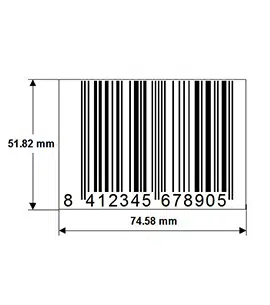Which GTIN is right for your product?
The following table provides examples of unique product identification at various levels. It also demonstrates how various GS1 barcodes can be used for GTINs.
| Description |
Item |
Level |
Barcode Type |
Encoded GTIN |
GTIN in Database |
| Product A |
1 Unit |
Consumer |
U.P.C.-A |
614141000012 |
00614141000012 |
| product a |
96 Unit Case |
consumer |
ITF-14 |
00614141000029 |
00614141000029 |
| product b |
1 Unit |
consumer |
U.P.C.-A |
614141000777 |
00614141000777 |
| product b |
6 Pack |
consumer |
U.P.C.-A |
614141000883 |
00614141000883 |
| product b |
12 Pack |
consumer |
U.P.C.-A |
614141000999 |
00614141000999 |
| product b |
2×12 Pack |
case |
GS1-128 |
10614141000996 |
10614141000996 |
What is a GTIN?
Global Trade Item Number, or GTIN, is a term used to describe the various versions of number structures that uniquely identify products and services.
Does GTIN replace the U.P.C.?
No, GTIN is a term only. The U.P.C. barcode symbol (also known as a U.P.C.-A) encodes a 12-digit GTIN. The U.P.C. does not go away; companies that place a GTIN-12 (U.P.C.) on products now should continue to do so.
Is a unique GTIN required for every level of packaging?
Yes. There should be a unique GTIN identifying the consumer unit, inner pack, multi-pack, case, or pallet where applicable.
What is GTIN compliance?
A company is considered GTIN compliant when it is able to process, store, and communicate information about its products with trading partners using all types of GTINs, whether 8, 12, 13, or 14 digits. Companies become GTIN compliant by expanding the appropriate systems and applications to 14 digits. This will support the GTIN on products at all levels of packaging (consumer, inner packs, multi-packs, cases, pallets, etc). A company must be GTIN compliant in order to take advantage of:
- Data synchronization using the Global Data Synchronization Network (GDSN).
- GS1 DataBar.
- Electronic Product Codes.
Does my company need a new GS1 Company Prefix to create GTINs?
No. You should continue to use the Company Prefix you have already licensed.
If a change is made to a product, does the GTIN need to change?
A separate unique GTIN is required whenever any of the pre-defined characteristics of a trade item are different in any way that is relevant to the trading process. The guiding principle here is that a new GTIN should be assigned to the new trade item if the consumer is expected to distinguish the new trade item from the old trade item and purchase accordingly. (Note that the product package and shelf edge label declarations should appear the same to the consumer.) For more information, refer to the GTIN Allocation Rules (available through the GS1 US Product Catalog) or to the Barcodes and Identification Numbers section of the Solutions Center.
When is a 9 used as the Indicator Digit in a GTINs?
A 9 is used to indicate a variable measure product, which is an item that is always produced in the same predefined version (e.g., type, packaging, design) that may be sold at any point in the supply chain and that may vary in weight or size or may be traded without a pre-defined weight, size, or length.
What are the correct ASC X12 EDI qualifiers for GTIN?
The correct qualifiers are as follows:
- UK for GTIN-14.
- EN for GTIN-13.
- UP for GTIN-12.
- EO for GTIN- 8.
Do you need to identify your products using GTIN symbology?
Contact ubs
Assigning GTINs to packaging levels
The following diagrams illustrate the assignment of GTINs at various item and package levels. Note that uniqueness can be achieved through the use of different Indicator Digits or different Item References at the higher levels of packaging:
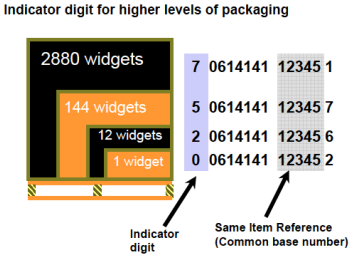
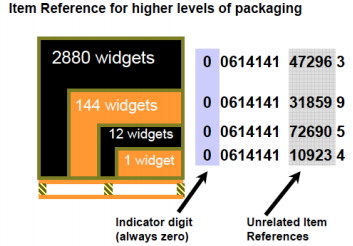
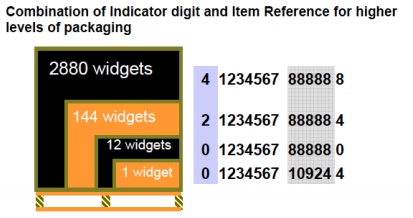
Avoiding mistakes in assigning a GTIN
When a GTIN is incorrectly assigned to products, the result is invoice errors and delays in products reaching the market. Following are several examples that demonstrate the most common mistakes made in assigning GTINs and how to avoid them.
Mistake #1: Assigning the Same GTIN to a Retail Unit and Case
The retail unit and the case each require a unique GTIN. In this example, the assigned GTIN for both packaging levels is 0 0614141 45324 5. The GTIN must differentiate between the two packaging levels. The symbology does not differentiate. A valid GTIN for the case would be 1 06 14141 45324 2.

Mistake #2: Using an Indicator Digit Without a Hierarchy
Using an Indicator Digit without a hierarchy can cause confusion for your trading partners, who may believe this is a case for a different GTIN-12 or U.P.C.. To correct the error, either the case should be marked using the Indicator Digit 1 with the same GTIN (recalculating the Check Digit to form the ITF in the GTIN-14, 1 06 14141 00324 9) or the case with an Indicator Digit 0 should be set up as its own GTIN (0 06 14141 45000 8).

Mistake #3: Using an Indicator Digit Without a Hierarchy
Because there is no packaging hierarchy for this product, the GTIN-14 must have an Indicator Digit of 0. Therefore, a valid GTIN for this item would be 0 06 14141 77777 8.
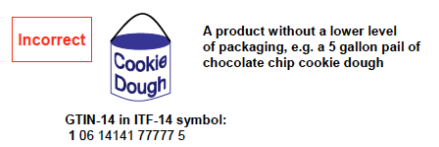
Mistake #4: Assigning an Incorrect GTIN for a Mixed Case
Because there is no packaging hierarchy for this product, the GTIN-14 must have an Indicator Digit of 0. Therefore, a valid GTIN for this item would be 0 06 14141 77777 8.

Mistake #5: Giving the Same Trade Item Two Different GTINs
Each trade item should be assigned a single unique GTIN. There should only be one symbol per package. In this case, two different GTINs have been assigned. If a second GTIN is needed based on trading partner requirements, the next best action is to assign the GTIN in the ITF-14 the same GTIN-12 that is used in the U.P.C.-A symbol: 0 0614141 76890 5.

Source: Here
